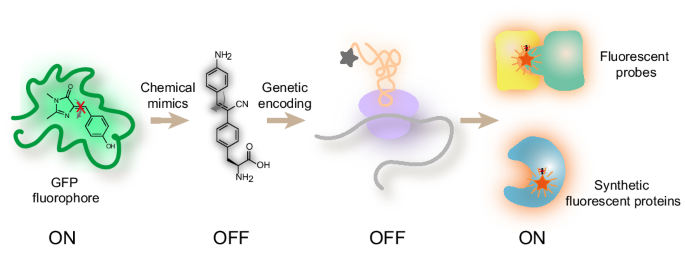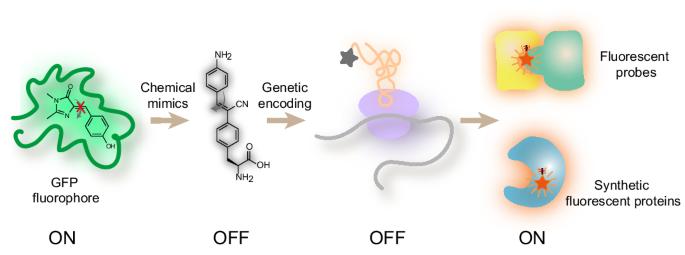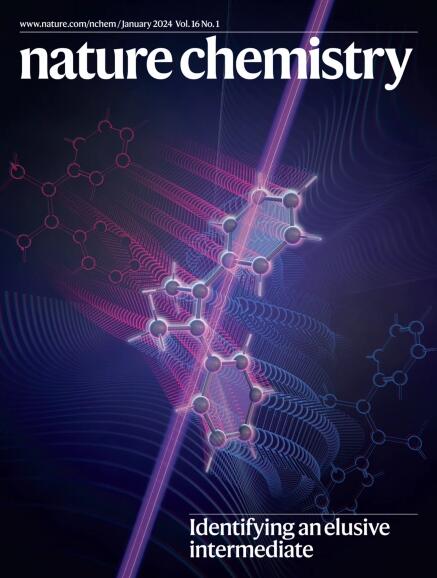通过对基于分子转子的氨基酸进行基因编码,设计人工荧光蛋白和生物传感器
IF 19.2
1区 化学
Q1 CHEMISTRY, MULTIDISCIPLINARY
引用次数: 0
摘要
荧光蛋白是生物和医学研究中不可或缺的工具。荧光蛋白通常由主氨基酸序列编码,在蛋白质折叠时形成荧光分子转子结构。受原生荧光团的致荧光特性启发,我们设计了一系列具有这种分子转子结构的致荧光非经典氨基酸--荧光分子转子氨基酸(FMR-AAs)--与原生荧光蛋白荧光团类似。我们通过扩展遗传密码将 FMR-AAs 加入目标蛋白质中,将其用作受限蛋白质微环境中的编码荧光团类似物,从而轻松地将各种非荧光蛋白质转化为人工荧光蛋白质。我们还将选定蛋白质中的 FMR-AAs 用作灵敏的荧光探针,用于监测蛋白质与蛋白质之间的相互作用,以及检测体外和活细胞中蛋白质构象的变化。通过这种方法,只需稍加改动,就能生成人工荧光蛋白,并利用可能感兴趣的任何蛋白质开发生物传感器。本文章由计算机程序翻译,如有差异,请以英文原文为准。


Designing artificial fluorescent proteins and biosensors by genetically encoding molecular rotor-based amino acids
Fluorescent proteins are indispensable tools in biological and medical research. The fluorophores are typically encoded by the primary amino acid sequence, from which a fluorescent molecular rotor structure forms upon protein folding. Here, inspired by the fluorogenic property exhibited by native fluorophores, we designed a collection of fluorogenic non-canonical amino acids that feature this molecular rotor structure—termed fluorescent molecular rotor amino acids (FMR-AAs)—akin to native fluorescent protein fluorophores. By incorporating FMR-AAs into target proteins through an expanded genetic code, we use them as encoded fluorophore analogues within a confined protein microenvironment, thus readily transforming diverse non-fluorescent proteins into artificial fluorescent proteins. We also use FMR-AAs in selected proteins as sensitive fluorescent probes for monitoring protein–protein interactions and detecting protein conformational changes in vitro and in living cells. This approach enables the generation of artificial fluorescent proteins and the development of biosensors from potentially any protein of interest with minor modifications. The toolbox of artificial fluorescent proteins can be expanded by engineering mimics of the molecular rotor-based fluorophore found in the green fluorescent protein (GFP) into diverse protein scaffolds. Now, by genetically encoding mimics of the GFP fluorophore, any protein of interest can be modified to fluoresce either under select circumstances or always (when folded).
求助全文
通过发布文献求助,成功后即可免费获取论文全文。
去求助
来源期刊

Nature chemistry
化学-化学综合
CiteScore
29.60
自引率
1.40%
发文量
226
审稿时长
1.7 months
期刊介绍:
Nature Chemistry is a monthly journal that publishes groundbreaking and significant research in all areas of chemistry. It covers traditional subjects such as analytical, inorganic, organic, and physical chemistry, as well as a wide range of other topics including catalysis, computational and theoretical chemistry, and environmental chemistry.
The journal also features interdisciplinary research at the interface of chemistry with biology, materials science, nanotechnology, and physics. Manuscripts detailing such multidisciplinary work are encouraged, as long as the central theme pertains to chemistry.
Aside from primary research, Nature Chemistry publishes review articles, news and views, research highlights from other journals, commentaries, book reviews, correspondence, and analysis of the broader chemical landscape. It also addresses crucial issues related to education, funding, policy, intellectual property, and the societal impact of chemistry.
Nature Chemistry is dedicated to ensuring the highest standards of original research through a fair and rigorous review process. It offers authors maximum visibility for their papers, access to a broad readership, exceptional copy editing and production standards, rapid publication, and independence from academic societies and other vested interests.
Overall, Nature Chemistry aims to be the authoritative voice of the global chemical community.
 求助内容:
求助内容: 应助结果提醒方式:
应助结果提醒方式:


